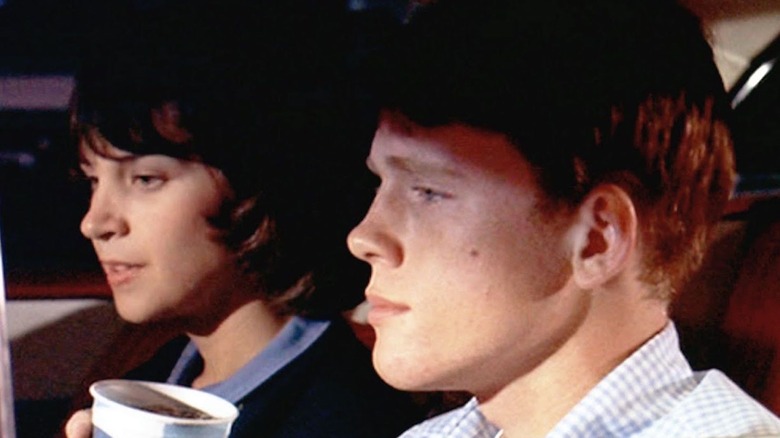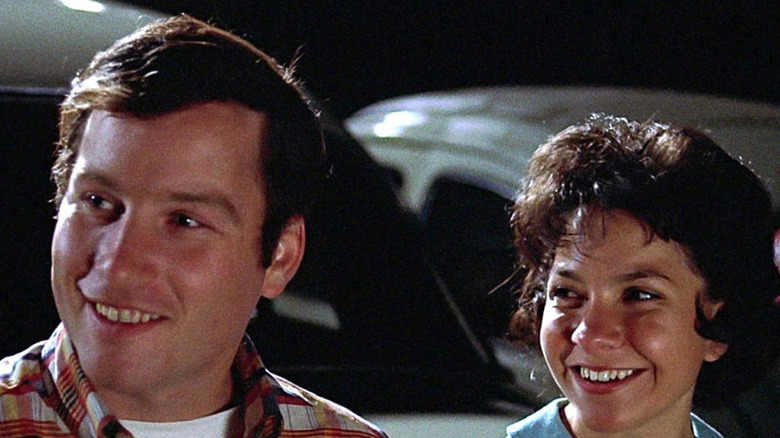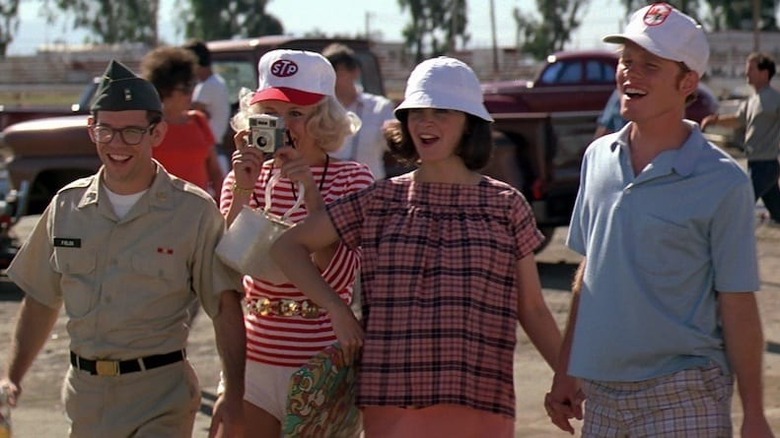American Graffiti Ending Explained: The Calm Before The Storm
Before the mammoth success of "Star Wars," George Lucas directed and co-wrote (along with Gloria Katz and Willard Huyck) the 1973 coming-of-age film "American Graffiti." A nostalgic slice of Americana pie filmed in a warm, naturalistic style, "American Graffiti" is the simple, wistful story of a group of California teenagers spending one last night together after their high school graduation in 1962. There's the best friends Curt Henderson (Richard Dreyfuss) and Steve Bolander (Ron Howard), the drag-racing John Milner (Paul Le Mat) and the nerdy Terry "The Toad" Fields (Charles Martin Smith). Harrison Ford makes an appearance as Bob Falfa, John's drag race rival.
They cruise the Modesto strip while listening to their favorite rock and roll songs, contemplating what lies ahead of them in their adulthood. Lucas uses the soundtrack to emphasize the carefree wonder of the teenagers' current lives and what they will be leaving behind. Curt has second thoughts about leaving his home with Steve to attend an East Coast college. Steve, on the other hand, looks forward to this change and tries to convince his devoted girlfriend Laurie (Cindy Williams) to break up so they can date other people. Terry meets the high-spirited bombshell Debbie (Candy Clark). The night unfolds with drag races, chasing a mysterious blonde in a Thunderbird, and listening to DJ Wolfman Jack on the radio.
Lucas' ending sees Curt and Steve's roles reversed: Steve promises to stay with Laurie after witnessing John and Bob's explosive drag race, and Curt bids goodbye to his parents and friends. While looking out the window of his plane, Curt sees the white Thunderbird driving below. Yearbook-style photos of the four male leads appear in a shot of the sky next to writing that reveals their adult fates. The inclusion of this title text drew some criticism.
What happens after 1962?
The title card states that John was killed by a drunk driver in 1964, Terry was declared missing in action near An Lộc in 1965, Steve works as an insurance agent in Modesto, and Curt is a writer living in Canada. Writers Gloria Katz and Willard Huyck did not agree with the inclusion of this epilogue. First, they were offended by Lucas' erasure of the female characters. So was Pauline Kael, who accused Lucas of misogyny in her New Yorker review (via S-UISH):
"Using women (and not only women) as plot functions may be a clue to the shallowness of many movies, even of much better movies — American Graffiti, for example. The audience at American Graffiti appears to be ecstatically happy condescending toward its own past — how cute we were at seventeen, how funny, how lost — but for women the end of the picture is a cold slap ... At the close, it jumps to the present and wraps up the fates of the four principal male characters as if lives were set ten years after high school! — and it ignores the women characters. This is one of those bizarre omissions that tell you what really goes on in men filmmakers' heads."
Huyck and Katz also found the characters' futures depressing, but this only adds more pathos to the film. "You can't stay 17 forever. We're not kids anymore," Steve tells Curt, and Lucas chooses not to remember his characters that way; instead, he briefly shows how the revolutionary 1960s affected them. "American Graffiti" purposefully takes place in 1962, exactly one year before John F. Kennedy's assassination changed everything. Kennedy's death turned America into a counterculture battleground, and George Lucas telegraphs a breezy time period for America's youth that would soon disappear.
How do the title cards impact "American Graffiti"? Filmphest argues "they do provide a contrast of the carefree past with the more troubling future, but they also kill some of the mystique around the picture and unnecessarily close events that could have been left more open-ended." I feel the details of the characters' destinies, some more somber than others, adds to the poignancy of Lucas' tender nostalgia; he depicts a blissful time in the teenagers' lives that will never happen again, and knowing how they end up makes their final night together even more bittersweet.
A strange sequel depicts the characters' adult lives
But there is more to the characters' stories. Bill L. Norton wrote and directed a bizarre sequel entitled "More American Graffiti," which follows most of the original characters (sans Richard Dreyfuss' Curt) during New Years Eve from 1964 to 1967. Norton sets each sequence apart using different formal techniques meant to capture the chaos and fragmentation of the counterculture era. For example, during the 1965 sequence in Vietnam, Norton uses grainy 16mm film with a hand-held camera on to evoke war reporters' footage.
"More American Graffiti" shows the core group of "American Graffiti" experiencing the cultural upheaval of the women's lib and anti-war movement. John is still a drag racer, and he falls in love with a woman from Iceland before heading off to his untimely death. We see Terry in Vietnam, so desperate to escape that he actually fakes his own death and hides in Europe, hence he's only stated as "missing in action." Debbie is now a hippie who becomes a country-western singer. Steve is married to Laurie and they have two children, but he resents her desire to start working. Laurie gets embroiled in Vietnam War protests with her draft-dodging brother, Andy.
Janet Maslin of The New York Times panned "More American Graffiti" as "grotesquely misconceived, so much so that it nearly eradicates fond memories of the original." In his review for The Washington Post, Gary Arnold critiqued Norton's visual experimentation:
"All this fussy, arbitrary switching of scenes, years and aspect ratios may wow them back in film school, but the complicated framework reveals nothing but one inconsequential or misleading vignette after another. Norton doesn't achieve a true dramatic convergence of parallel stories; and his historical vision is confined to cheerleading reaffirmations of all the old counterculture cliches about war, cops, Women's Liberation, you name it."
In 2021, The Guardian's Matt Mitchell encouraged audiences to reappraise the film as "an experimental love-letter to teenage omnipotence becoming adult mortality ... There is a beautiful melancholia lurking beneath the comedic surface. It's an empathetic look at the distances in which our sorrows can migrate."
While the impact the late 1960s had on the characters is certainly worth expanding on, the beauty of "American Graffiti" lies in its nostalgic preservation of an optimistic time in America. The title card at the end of "American Graffitti" does a great job of addressing the turbulent changes that were to come while still preserving the film's innocence. Whether or not you accept "More American Graffiti" as canon is up to you.


